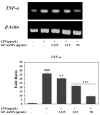Binary Effects of Gynostemma Gold Nanoparticles on Obesity and Inflammation via Downregulation of PPARγ/CEPBα and TNF-α Gene Expression
- PMID: 35566145
- PMCID: PMC9104634
- DOI: 10.3390/molecules27092795
Binary Effects of Gynostemma Gold Nanoparticles on Obesity and Inflammation via Downregulation of PPARγ/CEPBα and TNF-α Gene Expression
Abstract
Nanoscience is a multidisciplinary skill with elucidated nanoscale particles and their advantages in applications to various fields. Owing to their economical synthesis, biocompatible nature, and widespread biomedical and environmental applications, the green synthesis of metal nanoparticles using medicinal plants has become a potential research area in biomedical research and functional food formulations. Gynostemma pentaphyllum (GP) has been extensively used in traditional Chinese medicine to cure several diseases, including diabetes mellitus (DM). This is the first study in which we examined the efficacy of G. pentaphyllum gold nanoparticles (GP-AuNPs) against obesity and related inflammation. GP extract was used as a capping agent to reduce Au2+ to Au0 to form stable gold nanoparticles. The nanoparticles were characterized by using UV-VIS spectroscopy, and TEM images were used to analyze morphology. In contrast, the existence of the functional group was measured using FTIR, and size and shape were examined using XRD analysis. In vitro analysis on GP-AuNPs was nontoxic to RAW 264.7 cells and 3T3-L1 cells up to a specific concentration. It significantly decreased lipid accumulation in 3T3-L1 obese and reduced NO production in Raw 264.7 macrophage cells. The significant adipogenic genes PPARγ and CEPBα and a major pro-inflammatory cytokine TNF-α expression were quantified using RT-PCR. The GP-AuNPs decreased the face of these genes remarkably, revealing the antiadipogenic and anti-inflammatory activity of our synthesized GP-AuNPs. This study represents thorough research on the antiobesity effect of Gynostemma pentaphyllum gold nanoparticles synthesized using a green approach and the efficacy instead of related inflammatory responses.
Keywords: Gynostemma pentaphyllum; gold nanoparticles; inflammation; obesity; obesity-induced inflammation.
Conflict of interest statement
The authors have no conflicts of interest to declare. The authors alone are responsible for the content and writing of the article.
Figures













Similar articles
-
Green synthesis of gold nanoparticles using Euphrasia officinalisleaf extract to inhibit lipopolysaccharide-induced inflammation through NF-κB and JAK/STAT pathways in RAW 264.7 macrophages.Int J Nanomedicine. 2019 Apr 26;14:2945-2959. doi: 10.2147/IJN.S199781. eCollection 2019. Int J Nanomedicine. 2019. PMID: 31114201 Free PMC article.
-
In vitro anti-inflammatory activity of spherical silver nanoparticles and monodisperse hexagonal gold nanoparticles by fruit extract of Prunus serrulata: a green synthetic approach.Artif Cells Nanomed Biotechnol. 2018 Dec;46(8):2022-2032. doi: 10.1080/21691401.2017.1408117. Epub 2017 Nov 30. Artif Cells Nanomed Biotechnol. 2018. PMID: 29190154
-
Effects of heat-processed Gynostemma pentaphyllum on high-fat diet-fed mice of obesity and functional analysis on network pharmacology and molecular docking strategy.J Ethnopharmacol. 2022 Aug 10;294:115335. doi: 10.1016/j.jep.2022.115335. Epub 2022 May 2. J Ethnopharmacol. 2022. PMID: 35513215
-
Triterpenoids from the genus Gynostemma: Chemistry and pharmacological activities.J Ethnopharmacol. 2021 Mar 25;268:113574. doi: 10.1016/j.jep.2020.113574. Epub 2020 Nov 10. J Ethnopharmacol. 2021. PMID: 33186700 Review.
-
Green Synthesis of Gold Nanoparticles Using Plant Extracts as Beneficial Prospect for Cancer Theranostics.Molecules. 2021 Oct 22;26(21):6389. doi: 10.3390/molecules26216389. Molecules. 2021. PMID: 34770796 Free PMC article. Review.
Cited by
-
3,5-DCQA as a Major Molecule in MeJA-Treated Dendropanax morbifera Adventitious Root to Promote Anti-Lung Cancer and Anti-Inflammatory Activities.Biomolecules. 2024 Jun 15;14(6):705. doi: 10.3390/biom14060705. Biomolecules. 2024. PMID: 38927108 Free PMC article.
-
Pomegranate juice fermented by tannin acyl hydrolase and Lactobacillus vespulae DCY75 enhance estrogen receptor expression and anti-inflammatory effect.Front Pharmacol. 2022 Sep 29;13:1010103. doi: 10.3389/fphar.2022.1010103. eCollection 2022. Front Pharmacol. 2022. PMID: 36249796 Free PMC article.
-
Natural products in atherosclerosis therapy by targeting PPARs: a review focusing on lipid metabolism and inflammation.Front Cardiovasc Med. 2024 Apr 18;11:1372055. doi: 10.3389/fcvm.2024.1372055. eCollection 2024. Front Cardiovasc Med. 2024. PMID: 38699583 Free PMC article. Review.
-
Comparison of In Vitro Estrogenic Activity of Polygoni multiflori Radix and Cynanchi wilfordii Radix via the Enhancement of ERα/β Expression in MCF7 Cells.Molecules. 2023 Feb 27;28(5):2199. doi: 10.3390/molecules28052199. Molecules. 2023. PMID: 36903444 Free PMC article.
-
The Ethnopharmacological Properties of Green-Engineered Metallic Nanoparticles against Metabolic Disorders.Medicina (Kaunas). 2023 May 25;59(6):1022. doi: 10.3390/medicina59061022. Medicina (Kaunas). 2023. PMID: 37374226 Free PMC article. Review.
References
-
- World Health Organization . Global Action Plan on Physical Activity 2018–2030: More Active People for a Healthier World. World Health Organization; Geneva, Switzerland: 2019.
MeSH terms
Substances
LinkOut - more resources
Full Text Sources

